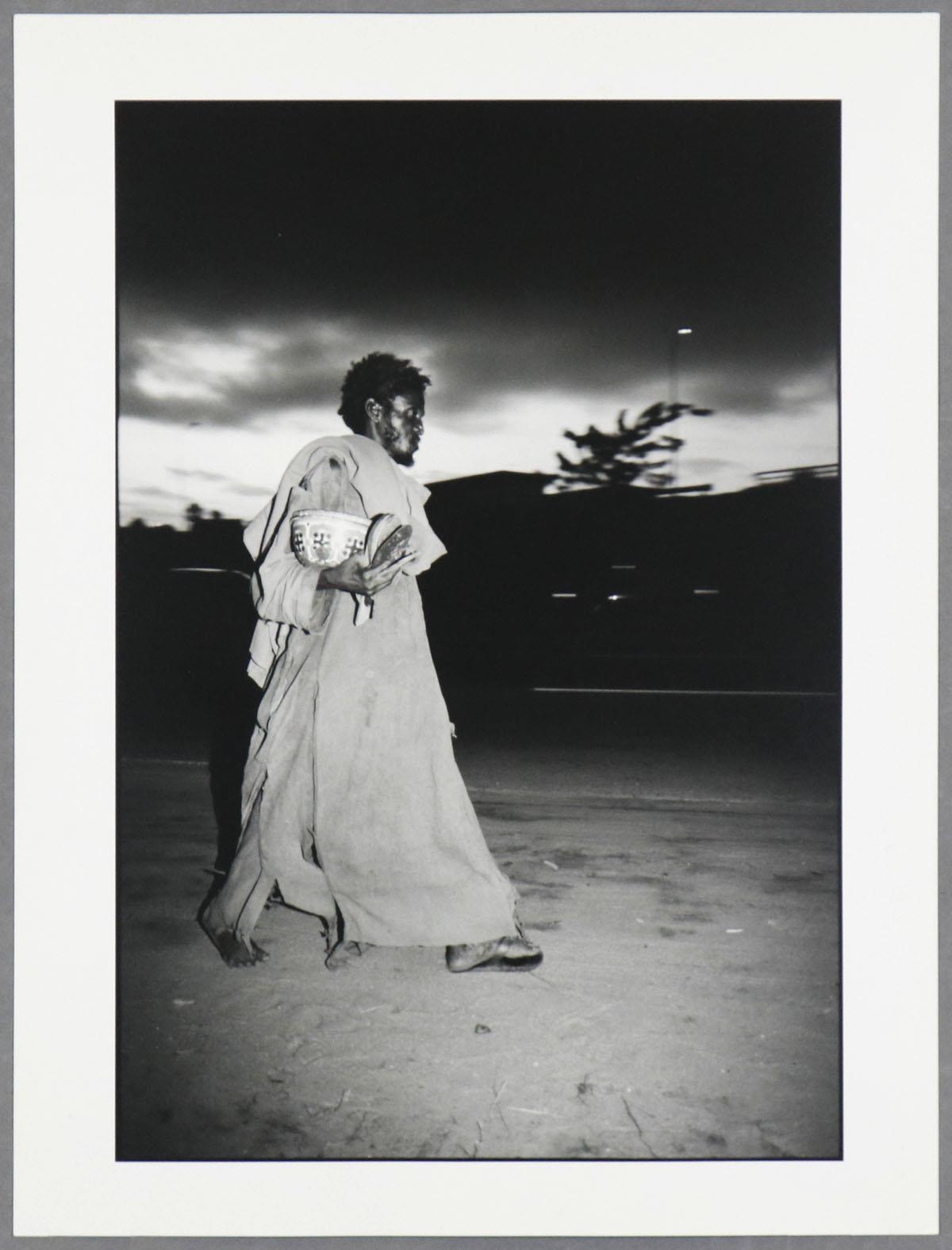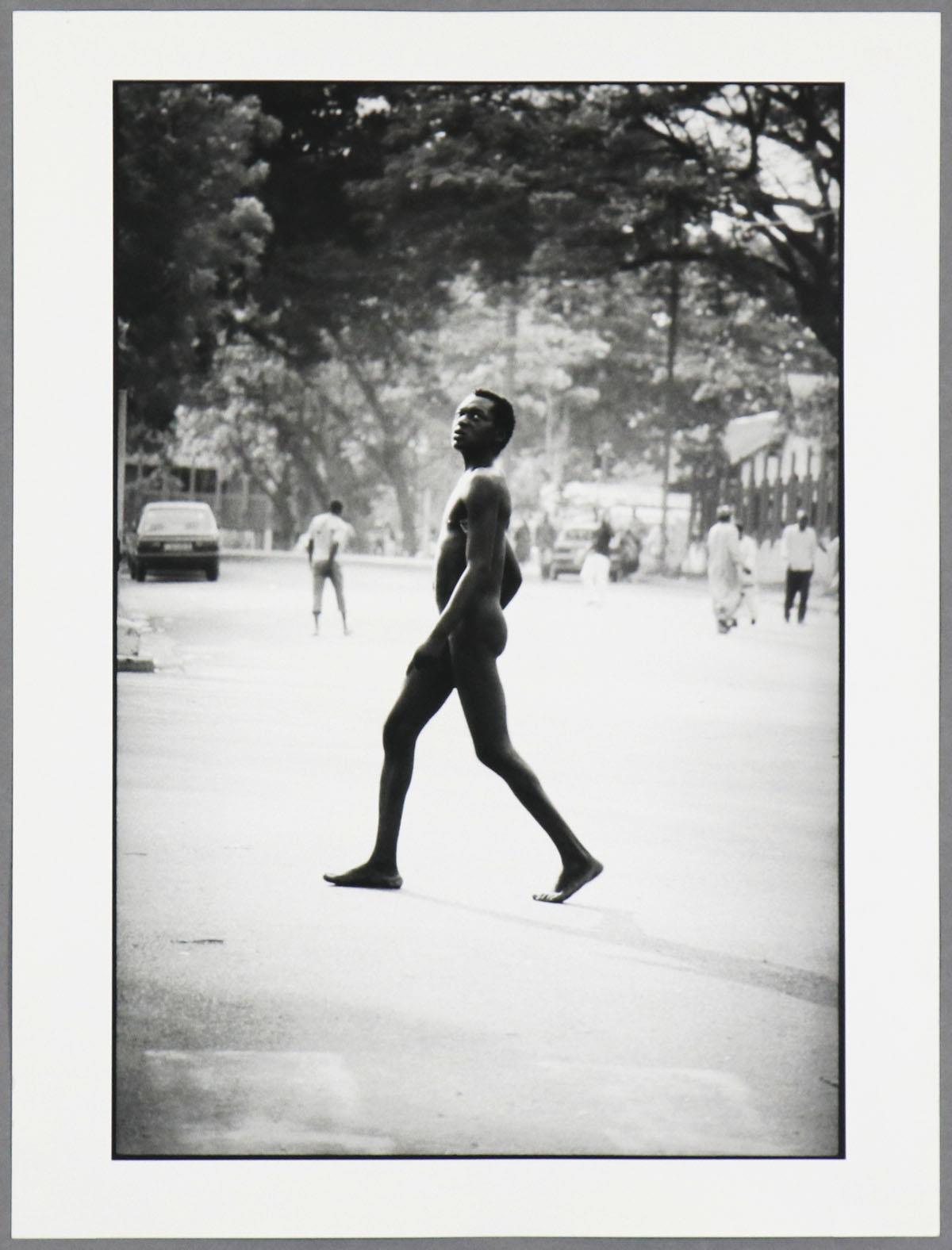Day after day and night after night, an unrehearsed theatre played out in the bustling streets of Abidjan; the economic capital of the Ivory Coast. Outcasts of the society took part as involuntary participants in what the locals called ‘Les fous d’Abidjan’; the madmen or crazy people of Abidjan. Some, completely naked men and women walking the streets. Others lying in the middle of the road, eating from trash bins and siting silently by the roadside. Although visible in the urban landscape, these ghostly existences were mostly ignored by the city’s cohabitants. Having just returned from his fashion studies in Paris,
Dorris Haron Kasco, an Ivorian himself and a young photographer, walked along and crossed the roads of Abidjan, also nicknamed as ‘la perle des lagunes’ or the ‘lagoon pearl’ due to its peculiar geographical location. Questioning where the solidarity usually found in everyday life in Africa had gone. Present but rejected, these madmen had been abandoned.
Less than twenty years into the independence from French colonialism, celebrated in the summer of 1960, the young ‘Republique de Cote d’Ivoire’ or Republic of the Ivory Coast was an economic miracle in Africa. Unlike other African countries, the country in its post-colonial transition had opened the borders to foreign educated labour, helping to build a new country. Its first President and his government had managed to lead a peaceful transition through religious, ethnical and cultural differences between people mostly living outside big cities. That in itself was an accomplishment in a new country where up to 78 languages are spoken and several of the major religions practised. By the end of the seventies, a divide emerged with wide-spread labour strikes and the country became increasingly unstable through political changes. This context, combined to others social and political factors, led to a coup d’état in 1999, followed by two tragic civil wars.

DORRIS HARON KASCO
Sans titre (Homme avec Bol, 1990), 2000
Edition of 200
30(w) x 40(h) cm
11.81(w) x 15.75(h) inches

DORRIS HARON KASCO
Sans titre (Homme avec Bol, 1990), 2000
Edition of 200
30(w) x 40(h) cm
11.81(w) x 15.75(h) inches
|
|
|
30(w) x 40(h) cm
11.81(w) x 15.75(h) inches
|
Matt gelatin silver print
From the series ‘Les fous d’Abidjan’
Signed and numbered on verso.
Image size: 24 (w) x 35 (h) cm.
Only 25 printed of the edition of 200.
Edition of 200
|
|
Kasco grew up in a young independent country filled with a vibrant can-do attitude. Influenced from a young age by fashion and mass-media, he flirted with the thoughts of a future lifestyle like the world portrayed in adverts and magazines: simple and luxurious. By the time he landed in Paris to study fashion-photography at the age of 21, he was already a passionate photographer inspired by his African peers.
In the late eighties, art photography in West-Africa had been in the making for decades. Artists such as Seydou Keïta (Malian, 1921 - 2001), August Azaglo (Ghanaian, 1924 - 2001) and Mama Casset (Senegalese, 1908 - 1992) established it on the world art scene. These artists’ works sprung from a West Africa, predominantly under French influence. Though informed by western portrait photography at the time, their works were not mirroring western imagery. Instead, they highlighted the beauty of African culture. Images of everyday-people wearing traditional African fabrics and jewellery, living the modern urban lifestyle in the capitals - or a traditional rural living in small countryside villages. The younger contemporaries in African art photography explored the field further.
Alioune Ba (Malian, born in 1959) with his poetic monochrome photographs of close-up shots of a silver ring on top of a flowery dress; or
Samuel Fosso’s (Cameroonian, born in 1962) modern and humorous self-portraits exploring identity while commenting on African history and cultures.
During Kasco’s studies in Paris the artist found an attraction for urban spaces rather than the polished world of fashion. After his graduation, and once he had returned to Abidjan in 1989, it was not the abundance of African culture he first noticed, but rather the people who had been forgotten. People living a ghostlike presence, often suffering from mental health issues, among the citizens in Abidjan. In the three years that followed Kasco trawled the city to document how they lived and survived in the commonplaces of the modern city: on roundabouts, at road intersections, on pavements, under bridges and in gutters.

DORRIS HARON KASCO
Sans titre (Fou nu Dans la Rue, 1989), 2000
Edition of 200
30(w) x 40(h) cm
11.81(w) x 15.75(h) inches

DORRIS HARON KASCO
Sans titre (Fou nu Dans la Rue, 1989), 2000
Edition of 200
30(w) x 40(h) cm
11.81(w) x 15.75(h) inches
|
|
|
30(w) x 40(h) cm
11.81(w) x 15.75(h) inches
|
Matt gelatin silver print
From the series ‘Les fous d’Abidjan’
Signed and numbered on verso.
Image size: 24 (w) x 35 (h) cm.
Only 25 printed of the edition of 200.
Edition of 200
|
|
The “madmen” he met were often mentally ill and driven out of villages as they were thought to be possessed or having supernatural powers. Most of them found a haven in the economic capital. Before photographing any of the subjects, Kasco first visited and spoke to them individually, trying to find an understanding of their thoughts and living, but frequently it was not easy to have a meaningful conversation. Some were lost in their own world like in
Sans titre (Homme avec Bol) showing a man dressed in rough linen and one sandal, carrying a bowl and two plates, simply walking along a street in the twilight. Some were calm and observant of the photographer, looking straight into the camera as portrayed in
Sans titre (Dreadlocks). Others were aggressive throwing objects at him, keeping Kasco at a distance.
Perhaps the most serene photo from the series is
Sans titre (Fou nu Dans la Rue) where a man is walking naked on the road in full daylight with people busy in the background. His posture is straight, his chin is up, glaring at the photographer. The exposure of the monochrome work makes “le fou” hover over the asphalt - only to be visually grounded by his long shadow.
Kasco’s photographs are confrontational. As a spectator to his social documentary work, the viewer is a witness to the unexplained existence of the “madmen” in Abidjan. Throughout history, major reforms and social change have been driven by similar impactful works, revealing various everyday sides of our lives and society we had become blind to see.
From Kasco’s early fascination with the carefully staged fashion photography, his practice could not have taken a sharper turn with this series of work. In ‘Les fous d’Abidjan’ he entered a world on the subjects’ premises. Everything close to the naked hardship in the moment of the snapshot. Nothing curated.
_2000.jpg)
DORRIS HARON KASCO
Sans titre (Dreadlocks, 1990), 2000
Edition of 200
30(w) x 40(h) cm
11.81(w) x 15.75(h) inches
_2000.jpg)
DORRIS HARON KASCO
Sans titre (Dreadlocks, 1990), 2000
Edition of 200
30(w) x 40(h) cm
11.81(w) x 15.75(h) inches
|
|
|
30(w) x 40(h) cm
11.81(w) x 15.75(h) inches
|
Matt gelatin silver print
From the series ‘Les fous d’Abidjan’
Signed and numbered on verso.
Image size: 24 (w) x 35 (h) cm.
Only 25 printed of the edition of 200.
Edition of 200
|
|
Dorris Haron Kasco photographic works ‘Les fous d’Abidjan’, showing the forgotten side of West Africa, rose to critically acclaim in the nineties - and the series was published by Revue Noire in a book by the same title in 1994. His work was included in two further publications: ‘Anthologie de la Photo Africaine’ (1998) and ‘Portrait Afrika’. In the years that followed,
Dorris Haron Kasco travelled his home country to create the first inventory of photographs from the Ivory Coast, which also led to film about the photograher August Azaglo; a film featured at the Bamako Encounters’ Photography Biennial in Mali in 2001. The series ‘Les fous d’Abidjan’ is as actual as ever and was re-exhibited at Paris Photo in 2016.
From the breakthrough series, ‘Les fous d’Abidjan’, three photographic editions were released by Eyestorm in an exclusive collaboration with
Dorris Haron Kasco in 2001 - and of the three works, two photo were originally included in the book from 1994. The works titled
Sans titre (Fou nu Dans la Rue) (‘Les fous d’Abidjan’, p 15) ,
Sans titre (Homme avec Bol) (‘Les fous d’Abidjan’, p 81) and
Sans titre (Dreadlocks) were printed as matt gelatin silver prints. Originally planned as editions of 200, only 25 were printed of each. The prints are signed, titled and numbered on verso.
You can find more information about the three photographic editions by
Dorris Haron Kasco on his artist page here.